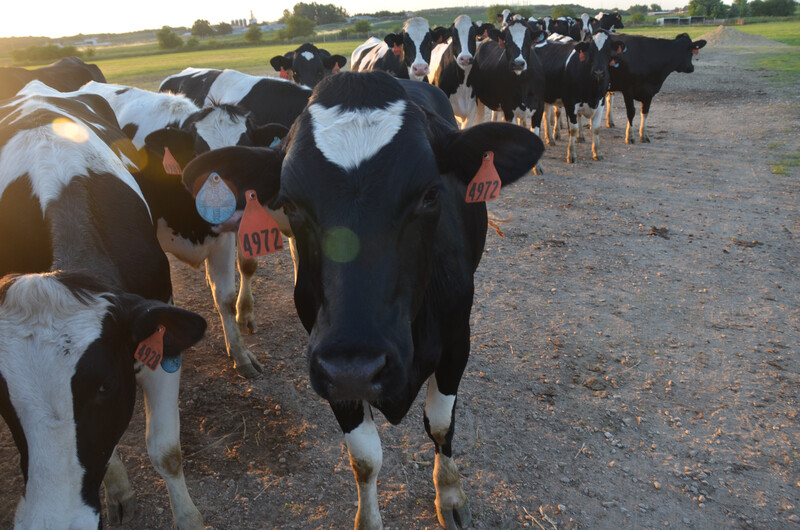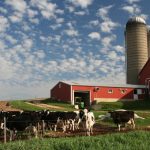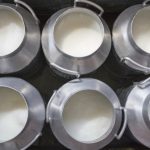
It equates to about $1.61 per gallon, up from $1.57 in September and $1.34 a year ago.
It is $3.29 above what California’s October 2018 4b cheese milk price was. The nation’s largest milk producing state marks the one year anniversary of entering the Federal order Milk Marketing Order system on Nov. 1.
The 2019 Class III average stands at $16.37, up from $14.72 at this time a year ago and $16.18 in 2017.
The October Class IV milk price is $16.39, up 4 cents from September and $1.38 above a year ago. The 2019 average stands at $16.23, up from $14.06 a year ago and $15.44 in 2017.
Central cheesemakers continue to report steady, somewhat tight milk supplies, according to Dairy Market News. Spot milk markets were quiet early in the week, as prices continue to fall in the $1-over Class area. Cheese production is still slightly slower than this time in recent years. Producers report shifting production to current market needs, as more Cheddar is being produced regionally.
Cheese demand is good for short term needs. Barrel makers continue to report mostly bullish demand and some process cheese manufacturers say they are oversold week to week. Cheese market tones are “bullish,” says DMN, but cheesemakers are concerned about how bullish. They say $2+ cheese on the CME are “creating a short-term, or necessity-based, purchasing environment. Buyers are not looking for anything longer term currently.”
Looking westward, the CME barrel pricing topping the blocks is a surprise to many, according to DMN, and contacts credit a tightness of barrels compared to blocks. Increased governmental cheese purchases seem to be helping that trend. Demands for the holiday are surfacing “bit by bit,” says DMN, but domestic sales were close to the previous week’s levels. Export sales have improved slightly. Cheese inventories are sufficient, cheese output is active, prompted by stable to increasing milk availability throughout the West.
FC Stone reported in its Oct. 28 Early Morning Update that “Eurostat keeps revising up European Union butter production data. Each state submits data on their own schedule, so data drips in, along with revisions to historical data, but presently the data looks like EU butter stocks will be up 20% by year end.”
DMN says there was concern that cream availability for churning could dwindle as Class II and Class III producers took more cream for holiday-related manufacturing but butter makers say that was not the case this week. Bulk butter supplies are generally available and market tones are “maintaining a steadiness that market participants are accustomed to.” Some analysts expect to see a sub-$2 price point prior to seeing $2.25 again. Others expect continued steadiness, explaining that with Thanksgiving falling later, on November 28th this year, it will assist the market later into the season.
Chinese milk equivalent imports for September were very close to forecast, according to FC Stone, up 1.7% from last year, but they predicted: “The growth rate for October should pick up quite a bit (into the 5-10% range). Food-type imports are still doing pretty good, but feed-type items, especially lactose, are holding back total milk equivalent imports.”
“Milk equivalent imports aren’t growing like they were in 2013/2014. First quarter 2014 total milk equivalent imports were up 43% with feed up 14% and food-type products up 52% (on top of 25% growth in first quarter 2013, says FC Stone.
Cheese imports were down 58.7% from August and down 2.9% from September 2018. Butter imports were down 56.3% from August and 7.4% below a year ago. Combined whole milk and skim milk powder imports were down 25.4% from August but were up 25% from a year ago. Whey imports were off 9.7% from August and 12.6% below a year ago.
The Daily Dairy Report however, says the U.S.-China trade dispute likely has more to do with the smaller figure. The DDR stated; “The United States was China’s largest whey trading partner in September, accounting for 28% of whey imports, matching November 2018 as the lowest share since September 2007. European countries benefited from lower U.S. imports, with volumes increasing 76% over the previous year, suggesting that smaller year-over-year volumes from the United States are related more to the trade dispute than ASF.”
The November Asia-Pacific Economic Cooperation meeting in Chile, where President Trump and China’s Xi Jinping were to meet, was canceled due to unrest in Chile but HighGround Dairy’s Lucas Fuess reported in the Nov. 4 Dairy Radio Now broadcast that China reportedly invited Trump to meet in Macau, China instead.
Fuess says there is still hope that Phase 1 of the trade agreement between the U.S. and China can be implemented and that agricultural purchases, including dairy products, will be made by the Chinese. China has made several promises of increased ag purchases, primarily corn and soybeans, says Fuess, but HighGround hopes they will include dairy products.
“There is nothing yet in writing,” Fuess cautioned, and “China continues to hesitate to commit to exactly how many agricultural products they will purchase.” He adds there was a “good sign” in that President Trump has held off imposing additional tariffs on Chinese imports, as he had previously threated to do.
Fuess also reported on Japan’s September dairy imports, which included record levels of cheese due to Japan’s declining domestic dairy production. He said that a lot of Japan’s dairy imports are from the US however we continue to compete with Europe and New Zealand. “If the price is right and the U.S. can compete, we can ship product away from our shores and fulfill the needs of foreign countries and hopefully have a good impact on our U.S. domestic prices.”
Cooperatives Working Together member cooperatives accepted eight offers of export assistance this week to help capture sales contracts for 952,397 pounds of Cheddar and Gouda cheese and 224,872 pounds of cream cheese. The product is going to customers in Asia and Oceania and will be delivered from November through March 2020.
In politics, the National Milk Producers Federation announced its support for the Farm Workforce Modernization Act, which they termed “a bipartisan immigration bill that advances agriculture immigration reform.”
Sponsored by Judiciary Immigration Subcommittee Chair Zoe Lofgren, D-CA, and Congressman Dan Newhouse, R-WA, NMPF says, “The legislation would provide legal status to current agricultural workers and their families and reform the H2A guest-worker visa program to permit year-round agriculture to participate, a crucial need for dairy. The efforts of Chairman Lofgren and Representative Newhouse, both longtime champions for agricultural labor reform, are greatly appreciated by dairy farmers, who cannot wait any longer for action.”
“America’s dairy farmers are eager to advance and improve this legislation as it moves through the Congress,” said Mike McCloskey, a dairy farmer and chairman of NMPF’s Immigration Taskforce. “As producers of a year-round product, dairy farmers face a unique labor crisis because our jobs are not seasonal or temporary. From our years of work on these issues, we know first-hand just how hard immigration reform is. But we simply cannot and will not stop working to find a solution. Dairy needs workers for our industry to sustain itself. It’s that simple, and it’s that dire.”
Jim Mulhern, NMPF President and CEO, thanked the lawmakers for “putting forward this essential step for agriculture labor reform, saying the bill is a critical first step in the legislative process.”
“We have supported numerous efforts to address dairy’s acute labor needs. Passing legislation in the House is a critical step in the process. We urge the Senate to work with us on this important issue so we can get an ag worker bill across the finish line in this Congress,” Mulhern said. “The bipartisan Farm Workforce Modernization Act provides an important starting point for badly needed improvements to agriculture immigration policy. NMPF would like to thank Chairwoman Lofgren and Congressman Newhouse for their bipartisan leadership, and we look forward to continuing to work with them as this important legislation moves forward.”
























